You went to the supermarket for a head of lettuce and some milk and you came out with two bags of groceries costing $80. Ever wonder why that happens? Victor Gruen understands why we buy more than we set out to. In fact, we can blame him for overspending on stuff we don’t need whenever we go shopping. The venerable Herr Gruen was an Austrian architect who designed America’s first outdoor pedestrian shopping mall in Kalamazoo, Michigan, and he gave his name to something called the Gruen Transfer. However, Gruen was not happy with the way retailers cynically co-opted his ideas.

How Stores Manipulate Customers
by RupertTaylor
The key to getting shoppers to make an impulse buy is to disorient them
Psychology at Work
Confusing layout is the key to success in the retail business
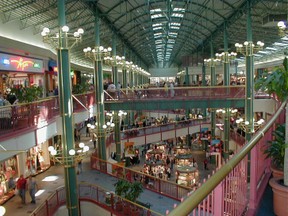 From the moment a shopper enters a store or mall he or she is bombarded with more stimuli than their brain can comfortably handle.
From the moment a shopper enters a store or mall he or she is bombarded with more stimuli than their brain can comfortably handle.
The idea is to disorient people so they lose track of their original intention.
In a 1992 essay architecture professor Dr. Margaret Crawford wrote that, “The Gruen Transfer… designates the moment when a ‘destination buyer,’ with a specific purchase in mind, is transformed into an impulse shopper, a crucial point immediately visible in the shift from a determined stride to an erratic meandering gait.”
Slightly glazed eyes and a dropped jaw are said to be other signals that someone is ready to buy something unwanted and unnecessary.
So, the Gruen Transfer is the moment when shoppers go from being all perky and alert to becoming putty in the hands of the store - "okay zombie, time to open your wallet."
It’s a science, and it’s not very pretty.
The Grocery Store
Bombarding the senses
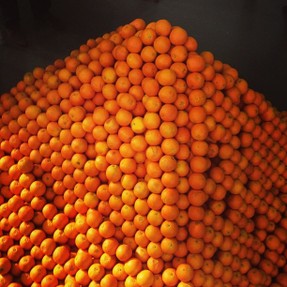 Paco Underhill, author of Why We Buy: The Science of Shopping, writes that “Two-thirds of what we buy in the supermarket we had no intention of buying.”
Paco Underhill, author of Why We Buy: The Science of Shopping, writes that “Two-thirds of what we buy in the supermarket we had no intention of buying.”
So, how do we get tricked into performing like circus animals and obeying the orders of the food ringmaster? It’s the Gruen Transfer working its magic:
- Lots of visual distraction in pyramids of oranges and apples;
- Smells from the bakery;
- Tastes from the sample stations; and,
- Music designed to make us walk slower.
If you’re not zoned out by the time you get to the high-profit prepared meals and boxed goods you are just not behaving like a properly trained shopper.
Supermarkets also game us into shelling out cash with product placement. The most-purchased items, such as milk and bread, are tucked into corners, forcing us to run the gauntlet of temptation to get at them.
And, the bulls-eye zone is eye-level shelving that holds the fastest-moving and highest-mark up goods. There's a bulls-eye zone for munchkins too; that's where the candy is.
The Ultimate Gruen Experience
IKEA has taking the lessons to heart
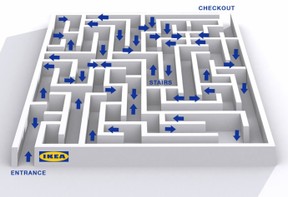 The Swedish retailing giant IKEA makes its customers cover a lot of ground before they can escape the enticement to make an impulse buy. You must navigate a zig-zag trail among the furniture sections while shiny things you don’t need pop out of unexpected places.
The Swedish retailing giant IKEA makes its customers cover a lot of ground before they can escape the enticement to make an impulse buy. You must navigate a zig-zag trail among the furniture sections while shiny things you don’t need pop out of unexpected places.
“Wow! That’s a really neat lamp, and that set of nesting baskets is a steal.”
There’s just one escalator up and then a maze through which you have to pass. Even if you have one item in mind you must pass lots of other goodies to get to it.
The baffling labyrinth is deliberate and works to reinforce buying on a whim. Alan Penn, director of the Virtual Reality Centre for the Built Environment at University College London, explains (Daily Mail, January 2011): “Here the trick is that because the lay-out is so confusing you know you won’t be able to go back and get it later, so you pop it in your trolley as you go past.” And, if you do have second thoughts, you can’t find your way back to drop it off where it belongs.
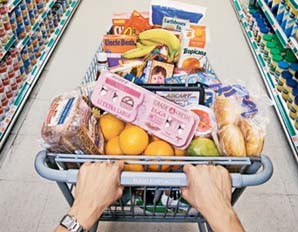 The well-trained shopper |
Others Use the System
Confusing the customer with bright lights and shiny things
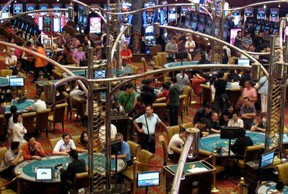 Casinos are masters of disorientation. There are no windows and no clocks so that punters lose track of time along with their money.
Casinos are masters of disorientation. There are no windows and no clocks so that punters lose track of time along with their money.
Theme parks like to induce a form of mental paralysis into their visitors in order to get them to stay longer and spend more.
In 2008, The Australian Broadcasting Corporation created a program called Gruen Planet “A show about advertising, PR, marketing, spin, and everything else they use to make us buy stuff we don’t need.”
It's required watching for those who wish to avoid being sucked into the consumerism vortex.
Gruen Planet
You might also like
Selling DreamsSelling dreams is pretty much what today's marketing is all about. Does it w...
How To Sell Foods at Farmers MarketsSelling foods at farmers markets and flea markets.
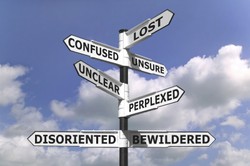



 American Cop Shakedownon 09/16/2014
American Cop Shakedownon 09/16/2014
 Corruption in Russiaon 06/27/2014
Corruption in Russiaon 06/27/2014
 The Oak Island Treasureon 03/21/2014
The Oak Island Treasureon 03/21/2014
 Measuring the Middle Classon 10/30/2013
Measuring the Middle Classon 10/30/2013

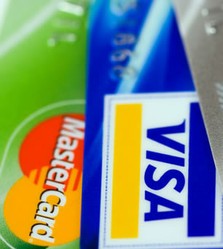

Comments
Well, this whole article reminds me of my husband's motto: "I go to buy. I don't go to shop," meaning he goes to get a certain item, and that's just what he does. Guess the folks at IKEA wouldn't like him much. He's never been there. (Nor have I!)
A good reason, then, to avoid such places. We have to be very disciplined to avoid being taken in.